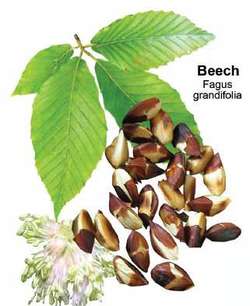Bottom:
American beech in forests of the eastern U.S.
Of the 110 observations of fledglings perched in deciduous trees or shrubs, 28.2% occurred in
American beech, by far the most commonly-used plant substrate.
Assessment of beech scale resistance in full- and half-sibling
American beech families.
Age Species Severe Moderate Light No Total Class Damage Damage Damage Damage 3-5
American beech 0 0 2 1 3 Aspen spp.
The northern hardwood species of these second growth forests, most commonly yellow birch (Betula alleghaniensis) or
American beech (Fagus grandifolia), provide nesting sites for CNFS in the form of large hollows and cavities as well as food cache sites, latrines, and natal sites [4,19, 20].
proterva were sampled in the canopy of mature
American beech trees and one in the canopy of a mature sugar maple on 7 June 2007.
White pine (Pinus strobus) and
American beech (Fagus grandifolia) sapwood blocks in dimensions of 14 by 14 by 14 mm were weighed after having been oven dried at 105[degrees]C.
Beech bark disease (Nectria coccinea) and beech bark scale (Cryptococcus fagisuga) were first recorded on
American beech in Canada in 1890.
For example, pawpaw (Asimina triloba),
American beech (Fagus grandifolia), and jewelweed (Impatiens capensis) are disturbance tolerant and/or unpalatable species that may inhibit regeneration of more sensitive species under browsing pressure.
-- In a mature southern mixed hardwood stand in Hardin County, Texas,
American beech (Fagus grandifolia) declined in basal area by 38% between 1985 and 2001, and 59% of the largest trees (>45 cm dbh) died (4.10%/yr).
Beech bark disease is an exotic disease complex involving the exotic beech scale (Cryptococcus fagi Baer) and at least two species of Neonectria fungi, which affects the
American beech tree (Fagus grandifolia).
This family's scaly sprigs jut out of the branches of South
American beech trees, and in blooming season, the female plants of several species grow silky blonde hair--swinging whisks of yellow filaments several inches long.
